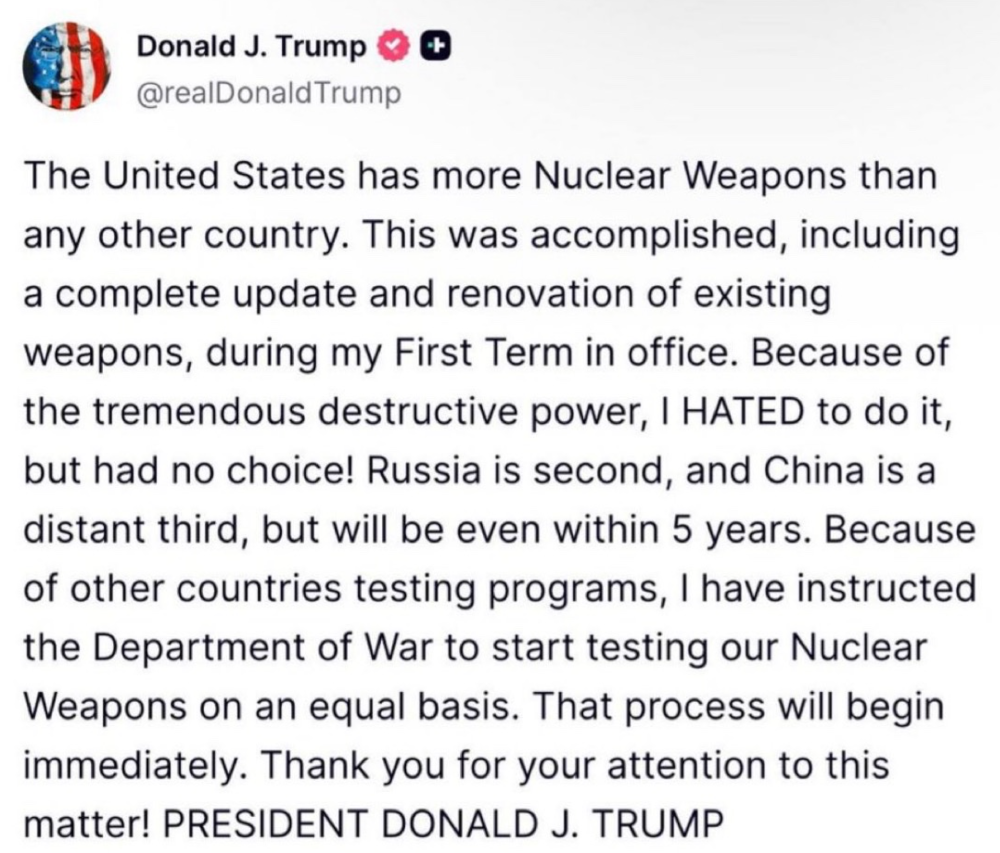Trump Orders Nuclear Weapons Testing
U.S. Equal Basis Nuclear Testing

In a bold and unexpected move, President Donald Trump announced on October 29, 2025, that he has directed the Pentagon to immediately resume nuclear weapons testing, marking the first such order since 1992.
The directive, shared via a post on Truth Social, cited the need for the United States to “match the testing programs of Russia and China,” signaling a potential escalation in global nuclear tensions amid rising geopolitical rivalries.
Trump’s statement came just ahead of a high-stakes bilateral meeting with Chinese President Xi Jinping during his diplomatic tour of Asia.
"Because of other countries’ testing programs, I have instructed the Department of War to start testing our Nuclear Weapons on an equal basis," Trump wrote. "That process will begin immediately."

The United States has maintained a self-imposed moratorium on nuclear testing since its last underground detonation in September 1992 at the Nevada Test Site. This policy aligned with international nonproliferation efforts, including the 1963 Limited Test Ban Treaty, which prohibits nuclear explosions in the atmosphere, outer space, or underwater — but allows underground tests.
Neither Russia nor China has conducted full-scale nuclear detonations since the 1990s — Russia’s last in 1990 and China’s in 1996 — though both nations have reportedly engaged in weapons modernization programs. Russia’s testing of advanced systems like the Burevestnik nuclear-powered cruise missile and the Poseidon undersea drone, alongside China’s rapid nuclear expansion, have fueled growing concern in Washington.
Trump’s order also follows reports of North Korean nuclear advancements and Russian demonstrations of new weaponry, which the president framed as direct threats requiring a U.S. response. The administration has not specified whether upcoming tests would involve subcritical experiments (non-yield tests) or full-scale detonations, with Trump emphasizing only an “equal basis” approach.
The era of U.S. nuclear testing peaked during the Cold War, with more than 1,000 tests conducted between 1945 and 1992 — many at the Nevada site and others across the Pacific. The 1992 moratorium, initiated under President George H.W. Bush and extended by successive administrations, was intended to advance arms control efforts culminating in the 1996 Comprehensive Nuclear-Test-Ban Treaty (CTBT). Although the U.S. signed the CTBT, it has never ratified it, leaving open the legal pathway for future testing.
Critics argue that modern computer simulations and subcritical tests have rendered explosive testing unnecessary to ensure the reliability of the U.S. arsenal. However, proponents within the defense community contend that renewed testing could be vital for validating new warhead designs and reinforcing deterrence. Analysts warn the decision may risk igniting a new global arms race, particularly in South Asia, where India and Pakistan could feel pressure to respond in kind.







